Fantasia 2018, Day 22, Part 2: The Vanished
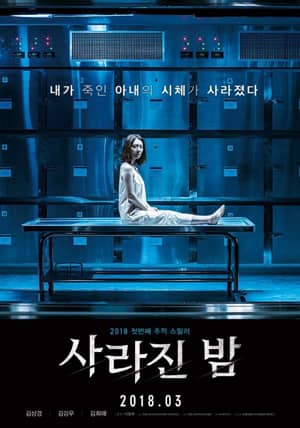 The second film I saw on the last day of Fantasia was a Korean remake of a Spanish original. The Vanished (사라진 밤) was written and directed by Chang-hee Lee, and is based on the 2012 film The Body (El cuerpo), which was written by Oriol Paulo and Lara Sendim and directed by Paulo. Lee’s film begins with a mysterious attack on a morgue security guard who may have seen a supposedly-dead woman (Hie-ae Kim) very much alive. At any rate, the body’s missing now. The police investigate, led by Jung-sik Woo (Sang-kyung Kim), who calls the husband of the deceased Seol-hee, Jin-han Park (Kang-woo Kim), to the morgue and ends up holding him for questioning. Did Jin-han have a hand in Seol-hee’s apparently-natural death? Or is someone seeking vengeance on him? What about his mistress, Hye-jin (Ji-an Han)? Questions and strange incidents multiply, as the police struggle to solve the crime before dawn, when they must let Jin-han go.
The second film I saw on the last day of Fantasia was a Korean remake of a Spanish original. The Vanished (사라진 밤) was written and directed by Chang-hee Lee, and is based on the 2012 film The Body (El cuerpo), which was written by Oriol Paulo and Lara Sendim and directed by Paulo. Lee’s film begins with a mysterious attack on a morgue security guard who may have seen a supposedly-dead woman (Hie-ae Kim) very much alive. At any rate, the body’s missing now. The police investigate, led by Jung-sik Woo (Sang-kyung Kim), who calls the husband of the deceased Seol-hee, Jin-han Park (Kang-woo Kim), to the morgue and ends up holding him for questioning. Did Jin-han have a hand in Seol-hee’s apparently-natural death? Or is someone seeking vengeance on him? What about his mistress, Hye-jin (Ji-an Han)? Questions and strange incidents multiply, as the police struggle to solve the crime before dawn, when they must let Jin-han go.
This is a movie that challenges the audience to work out what’s happening. Theoretically, even describing what genre it is could be construed as a spoiler; there’s an experimental drug that enters the story, and opens the door to various different possibilities. I can say, though, that there’s a fair-play aspect to the film. It’s quite possible to figure out by at least the half-way mark roughly what’s happening. For better or worse, I can say this because I did figure out what was happening without particularly trying to. I don’t know that it’d be fair to say that the film’s obvious, though; I happened to pick up on a couple of visual clues, and I’m not sure whether that’s chance or whether that’s good directing by Lee. I suspect it’s not intended, as certain scenes played out as though they were still meant to be mysterious. At any rate, I can say that if a certain amount of tension necessarily goes out of the film when you know what’s going on, it continues to be a solid story.
Some of that is just because The Vanished is technically sound. The location where much of it takes place, the morgue that stores Seol-hee’s body, is shot remarkably well. It has a slick, high-tech feel, but also a definite horror sense. There’s something claustrophobic about the building, filled with small rooms and odd nooks. And echoing halls, and an emptiness that can’t be defined. Conversely, the film also uses flashbacks fairly extensively, so the audience doesn’t get bored of the location. The lighting’s moody at every turn, but is on the whole notably brighter in flashback — still cold, still atmospheric, but brighter than the shadow-filled morgue. Tension’s ramped up by the time element: a clock appears every so often on screen, reminding us how little time remains before Jin-han has to be released, and making us question whether we should be rooting for him or against him.
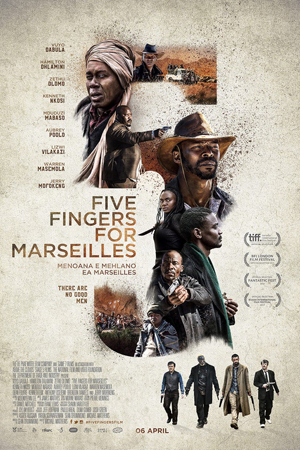 I went by the screening room early on August 2, the last day of the 2018 Fantasia International Film Festival. It was my final chance to see some of the things I’d missed at the festival, and if I watched three movies in the screening room before heading off to watch the two films I wanted to see that evening at the Hall Theatre, then I’d total 60 movies on the year. And I knew going in what the first film I wanted to see at the screening room was, a film that had gathered a goodly amount of buzz around the festival. On the first day of the festival I’d begun Fantasia 2018 with the revisionist Western
I went by the screening room early on August 2, the last day of the 2018 Fantasia International Film Festival. It was my final chance to see some of the things I’d missed at the festival, and if I watched three movies in the screening room before heading off to watch the two films I wanted to see that evening at the Hall Theatre, then I’d total 60 movies on the year. And I knew going in what the first film I wanted to see at the screening room was, a film that had gathered a goodly amount of buzz around the festival. On the first day of the festival I’d begun Fantasia 2018 with the revisionist Western 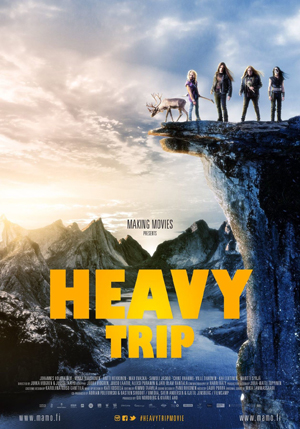 I had time for one more movie in the Fantasia screening room before I’d head over to the J.A. De Sève Theatre to watch a film called Madeline’s Madeline, an experimental film about a girl in a theatre group struggling to define herself. It’d be the last movie I’d see in the De Sève at this year’s festival, but before it started I opted to watch a Finnish comedy about death metal. (There’s a reason for that choice, involving the final film of the festival; more on that in a few posts.)
I had time for one more movie in the Fantasia screening room before I’d head over to the J.A. De Sève Theatre to watch a film called Madeline’s Madeline, an experimental film about a girl in a theatre group struggling to define herself. It’d be the last movie I’d see in the De Sève at this year’s festival, but before it started I opted to watch a Finnish comedy about death metal. (There’s a reason for that choice, involving the final film of the festival; more on that in a few posts.)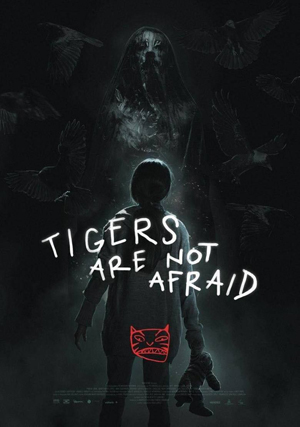 I was at the Fantasia screening room early on August 1 to watch a movie I’d missed when it played in a Fantasia theatre: Tigers Are Not Afraid (Vuelven), written and directed by Issa López. I’d heard a number of people around the festival rave about it, and I was intrigued. 10-year-old Estrella (Paola Lara) is a girl in a Mexican city ravaged by drug violence. When her mother goes missing, she falls in with a gang of four boys who live on the street. But their leader, a scarred child named Shine (Juan Ramón López), has stolen a cell phone containing a video incriminating an aspiring local politician (Tenoch Huerta) in brutal criminal activity. Now his cartel’s after them, and death is all around. So, perhaps, is magic; but magic is not always safe.
I was at the Fantasia screening room early on August 1 to watch a movie I’d missed when it played in a Fantasia theatre: Tigers Are Not Afraid (Vuelven), written and directed by Issa López. I’d heard a number of people around the festival rave about it, and I was intrigued. 10-year-old Estrella (Paola Lara) is a girl in a Mexican city ravaged by drug violence. When her mother goes missing, she falls in with a gang of four boys who live on the street. But their leader, a scarred child named Shine (Juan Ramón López), has stolen a cell phone containing a video incriminating an aspiring local politician (Tenoch Huerta) in brutal criminal activity. Now his cartel’s after them, and death is all around. So, perhaps, is magic; but magic is not always safe. On Tuesday, July 31, the first movie I planned to see alongside a general audience was a Hong Kong action movie called The Brink. After that, I’d pass by the screening room before heading home. There’d be only two more days of Fantasia after this one, and I wanted to catch up on things I’d missed in theatres. I was specifically curious about a Korean movie called The Outlaws, about a cop who’s working against the clock to catch a Chinese gang who’re trying to take over territory in a district of Seoul. Two promising action movies; I had reasonable hopes for the afternoon.
On Tuesday, July 31, the first movie I planned to see alongside a general audience was a Hong Kong action movie called The Brink. After that, I’d pass by the screening room before heading home. There’d be only two more days of Fantasia after this one, and I wanted to catch up on things I’d missed in theatres. I was specifically curious about a Korean movie called The Outlaws, about a cop who’s working against the clock to catch a Chinese gang who’re trying to take over territory in a district of Seoul. Two promising action movies; I had reasonable hopes for the afternoon. I was at the J.A. De Sève Theatre early on Tuesday, July 31, for a press screening of Mandy. It’s the second film by Panos Cosmatos (director of Beyond the Black Rainbow), who also wrote the script with Aaron Stewart-Ahn. The movie stars Nicolas Cage as Red Miller, a lumberjack who lives in a cottage in the deep woods of the Shadow Mountains with his wife Mandy (Andrea Riseborough), a metalhead artist, in the long-ago year of 1983. Mandy unwittingly catches the eye of a cult leader (Linus Roache), whose minions, the Children of the New Dawn, abduct her. Bad things happen. Miller is tortured. And, inevitably, he embarks on a quest for bloody revenge.
I was at the J.A. De Sève Theatre early on Tuesday, July 31, for a press screening of Mandy. It’s the second film by Panos Cosmatos (director of Beyond the Black Rainbow), who also wrote the script with Aaron Stewart-Ahn. The movie stars Nicolas Cage as Red Miller, a lumberjack who lives in a cottage in the deep woods of the Shadow Mountains with his wife Mandy (Andrea Riseborough), a metalhead artist, in the long-ago year of 1983. Mandy unwittingly catches the eye of a cult leader (Linus Roache), whose minions, the Children of the New Dawn, abduct her. Bad things happen. Miller is tortured. And, inevitably, he embarks on a quest for bloody revenge.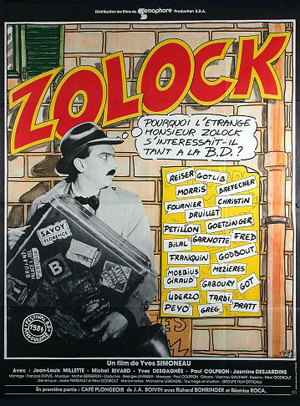 The
The  I had three films on my schedule for Monday, July 30. First, an animated science-fictional retelling of Cinderella for adults, called Cinderella the Cat. Then I’d hurry from the J.A. De Sève Theatre to the Centre Cinéma Impérial, where Fantasia was presenting a documentary from the early 80s about bandes dessinées: Pourquoi l’étrange Monsieur Zolock s’intéressait-il tant à la bande dessinée? Then I’d run back to the Hall Theatre for a presentation of Sion Sono’s Tokyo Vampire Hotel, a kinetic horror-action film with campy apocalyptic overtones. Even for Fantasia, it was going to be a strange day.
I had three films on my schedule for Monday, July 30. First, an animated science-fictional retelling of Cinderella for adults, called Cinderella the Cat. Then I’d hurry from the J.A. De Sève Theatre to the Centre Cinéma Impérial, where Fantasia was presenting a documentary from the early 80s about bandes dessinées: Pourquoi l’étrange Monsieur Zolock s’intéressait-il tant à la bande dessinée? Then I’d run back to the Hall Theatre for a presentation of Sion Sono’s Tokyo Vampire Hotel, a kinetic horror-action film with campy apocalyptic overtones. Even for Fantasia, it was going to be a strange day.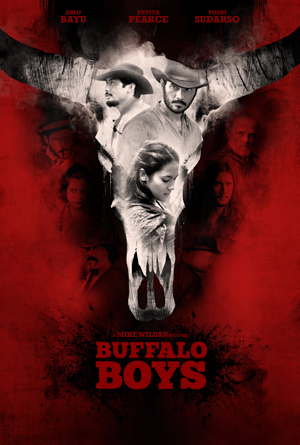 Before writing about the movies I saw during the last weekdays of the Fantasia festival, I’m going to skip back to the beginning to write about some films I watched before attending my first screening this year with a general audience. At a festival with 130 movies, most of which are shown in a theatre once or maybe twice, one has to make some hard choices about which to see. Fortunately, Fantasia’s screening room gives harried film critics the chance to catch some of the movies they have to miss in theatres due to one scheduling exigency or another. I passed by on the first day of the festival, and found that this year the screening room offered curtained cubicles and a healthy selection of films. Among them was an Indonesian western named Buffalo Boys, an experimental German horror film called Luz, and a transgressive French animated webseries titled Crisis Jung.
Before writing about the movies I saw during the last weekdays of the Fantasia festival, I’m going to skip back to the beginning to write about some films I watched before attending my first screening this year with a general audience. At a festival with 130 movies, most of which are shown in a theatre once or maybe twice, one has to make some hard choices about which to see. Fortunately, Fantasia’s screening room gives harried film critics the chance to catch some of the movies they have to miss in theatres due to one scheduling exigency or another. I passed by on the first day of the festival, and found that this year the screening room offered curtained cubicles and a healthy selection of films. Among them was an Indonesian western named Buffalo Boys, an experimental German horror film called Luz, and a transgressive French animated webseries titled Crisis Jung.  By Eva and Matthew Surridge
By Eva and Matthew Surridge